Desert retreat in Steve Martino-designed Quartz Mountain Garden
The second garden I visited with Phoenix landscape architect Steve Martino was familiar to me from a magazine or garden book I’d read. Peer recognition, including an ASLA design award in 2006, has also been bestowed on Steve’s design for this Paradise Valley, Arizona, home. It’s a high-end design, but it offers plenty of inspiration for any gardener.
Let’s start with sculptural native plants — ocotillo and prickly pear — against a fiery red wall. Color and form — simple but effective.
Steve worked with the homeowners to open their house to the outdoors, bringing in light and views but shielding the interior from harsh desert sunlight through the use of shade structures, arbors, and screening. This is the outer edge of a wall that helps enclose a dining terrace. A shelf fountain set into the wall masks road noise and adds the cooling sight of water to the dry garden.
Canary-yellow palo verde trees in full bloom over the red wall
A wider view reveals the pleasing visual heft of the patio roof, which surprisingly “floats” above the back wall, letting air and light pass through. A cut-out window in the wall frames a view of…
…columnar cactus. I love how the woven texture of the chairs repeats the ribbed texture of the cactus.
And, oh, that window! From the other side of the wall, along the driveway, it frames a mountain vista.
The covered dining terrace steps down to a large gravel patio casually furnished with Adirondacks…
…and an umbrella for shade.
But the fireplace wall and chairs clustered around it suggest that this space is mainly used in the evening, when the dry desert air can get chilly and a fire provides a cozy focal point.
The gravel patio gives way to a play lawn for the children. Reducing the lawn to the size needed for play is a good way to save water in a dry climate. And when the kids grow up, the lawn can be replaced by low-water plants or a larger patio.
Opuntia in flower
Panels of shade screening are covered by what I first thought was crossvine or some other orange-flowering vine. But a closer inspection revealed that it’s lantana — lantana climbing up to the roof! I asked Steve how he’d done it; I’ve never known lantana to climb like this. He said he didn’t know — it had just done it. I love garden surprises like this.
Looking across the play lawn toward the mountain view. This view was obscured by non-native trees before Steve transformed the garden. A taupe wall at the end of the play lawn…
…forms the back of a huge, L-shaped, blue-cushioned banquette banco near the swimming pool. A gas fire pit is set into the patio for evening warmth. But the stunner is of course that mountain view.
I’ve never been a fan of bougainvillea, which seems to shout with its insistent, lipstick-bright color. But, as with many tropical plants, it works well alongside a pool. Still, if it was mine (hey, I can fantasize!), I’d plant upright aloes or ‘Sticks on Fire’ euphorbia here.
A side view shows a negative-edge water feature just beyond the banquette banco.
The banco patio leads to a swimming pool framed by a cobalt-blue wall. A convex steel plate supports another shelf fountain, which spills into the pool. Aloes elevated on pedestals send up yellow bloom spikes.
The blue-tinged aloes echo the blue of the wall.
Patio dining. Blue cushions in the chairs continue the color theme of the pool garden.
Aloe vera blooming against the taupe wall of the house
This place is made for entertaining. Another seating area extends behind the pool, with cushy chairs overlooking a sport court below. Yellow-flowering palo verde colors the background.
Steps lead down to a sunken garden, a private space with a single banquette banco and geometric paving set in a small, emerald lawn. Another fire pit is ready for cool evenings. Sculpture and a sheltering palo verde tree add to the contemplative, restful atmosphere of this garden room.
The owner has placed a number of sculptural pieces throughout the garden, including this ballerina perched on a steel wall. She seems to be walking a balance beam.
On the other side of the house, the afternoon light illuminated this scene: palo verde, aloes, agave, and desert shrubs backed by a purple wall and a series of vertical steel plates that screen a side patio from view of the parking area.
A closer look
The side patio is humbler than the contemporary, newer spaces on the other side of the house. I like that the owners didn’t feel they had to tear out all the older parts of their home when they remodeled. Instead this cozy courtyard patio provides a garden entry to the home from the driveway.
I love this steel-pipe “picket fence.”
Aloe in bloom
Cool garden art
Another shelf fountain, set in a purple wall, is the focal point of the courtyard. Unfortunately it was not working during my visit.
In the adjacent parking area, a narrow planting bed is squeezed into the wall along the driveway, elevating a row of white-spined cactus that incandesce in the afternoon light.
Out by the street, a wall fountain splashing into a steel-edged rectangular pool announces the garden entry.
Shadows animate a translucent mesh panel at the end of the wall.
Along one side of the driveway, a low, red, serpentine wall wriggles toward the gate, with agaves and prickly pear providing a green counterpoint to that line of rich color.
The palo verdes were doing their best to outshine everything else on this early April visit.
My thanks to Steve and the homeowners for sharing this beautiful garden with me. For a look at the 1st garden I visited with Steve, click here.
All material © 2006-2014 by Pam Penick for Digging. Unauthorized reproduction prohibited.


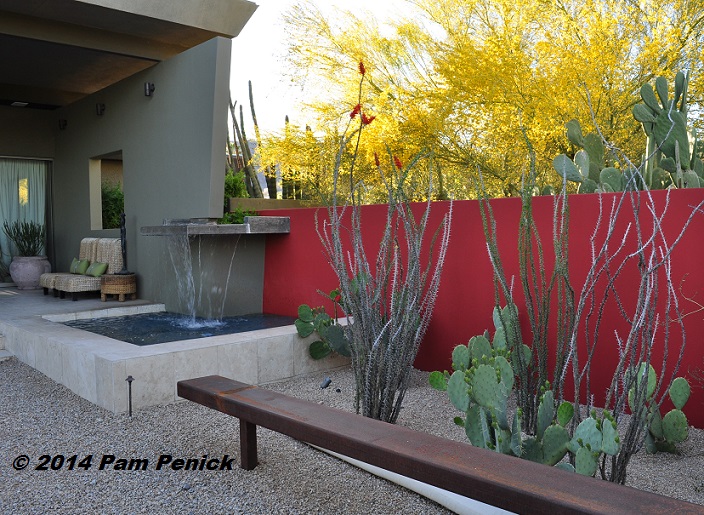
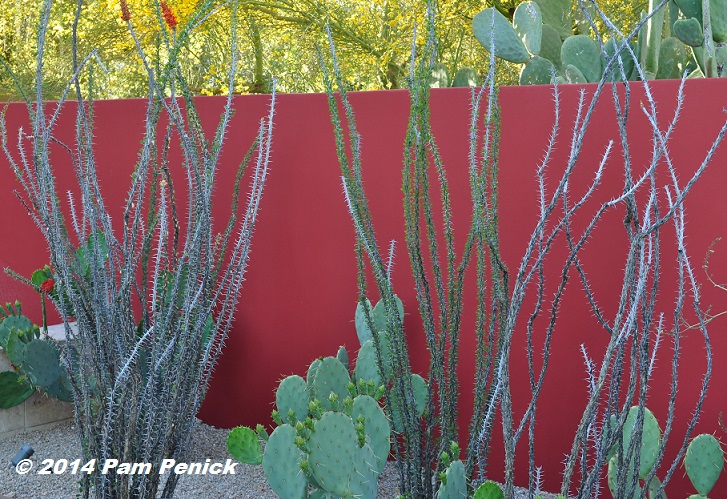
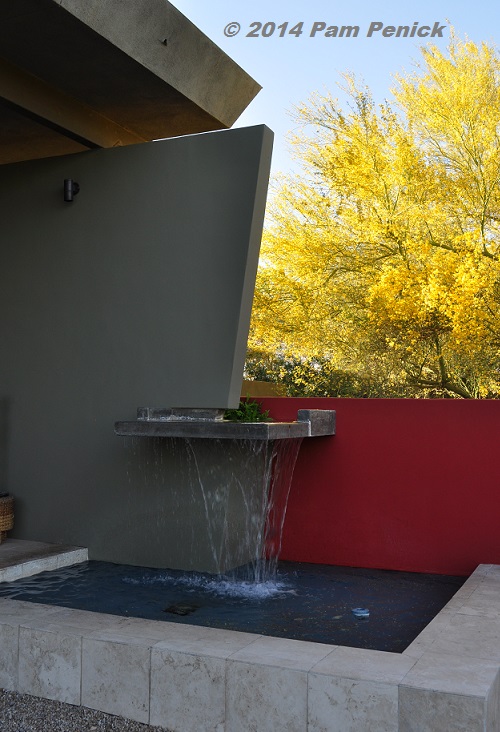
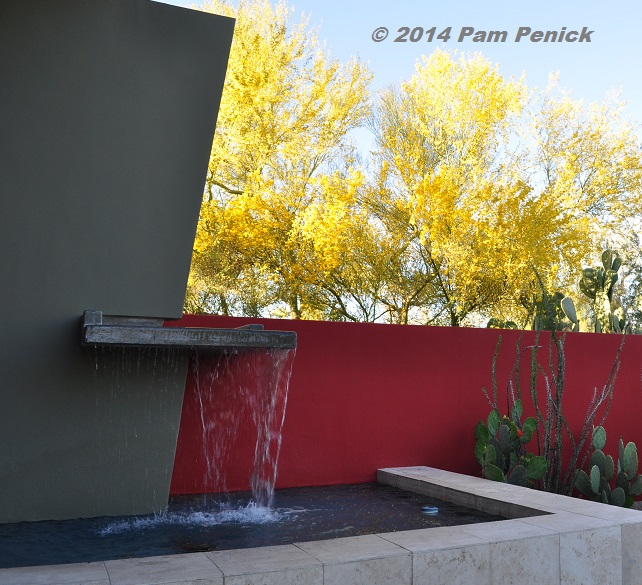
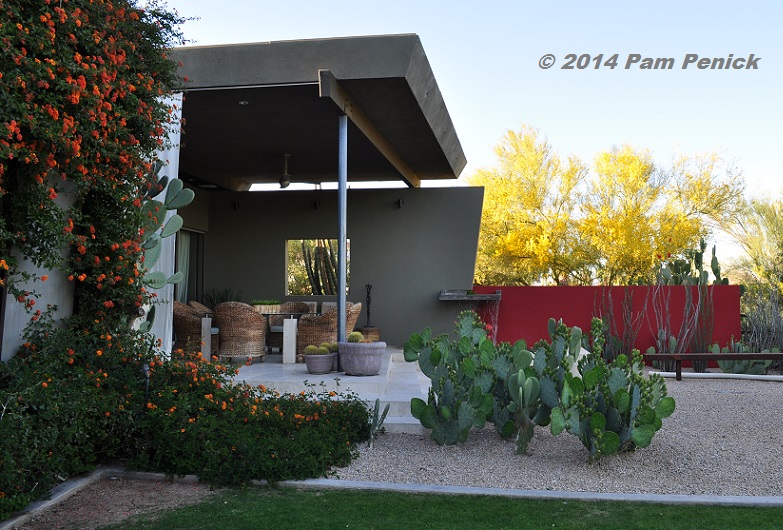
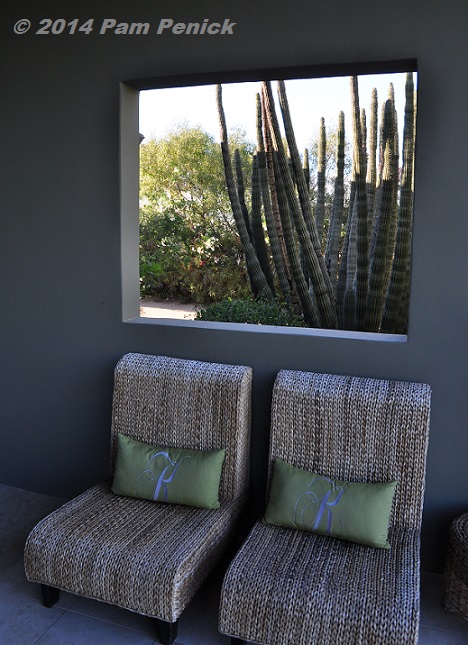
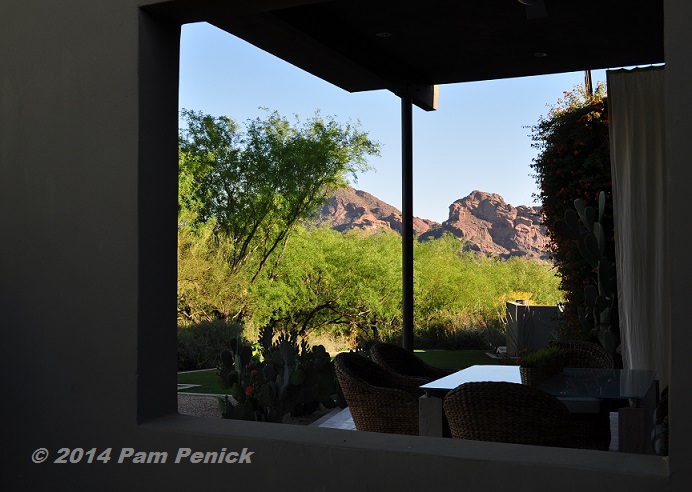
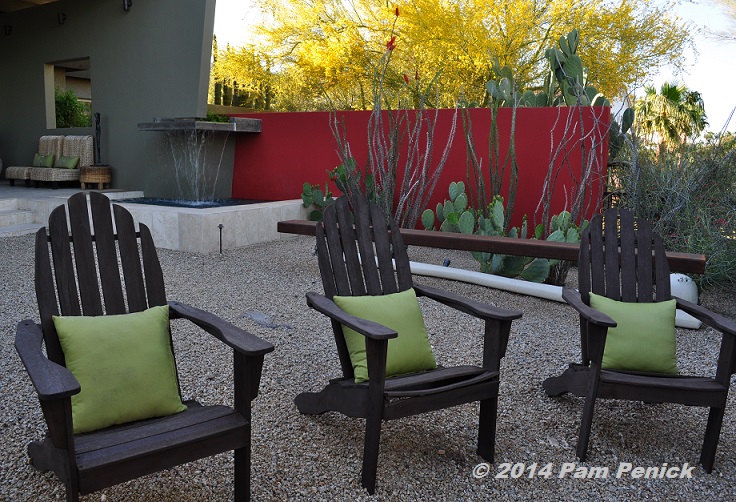
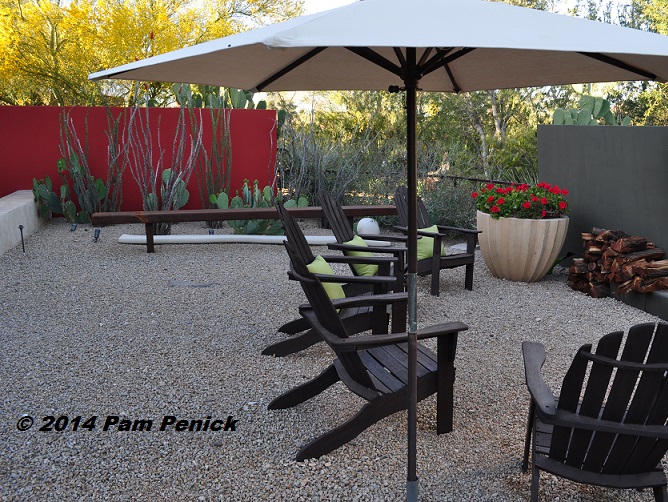
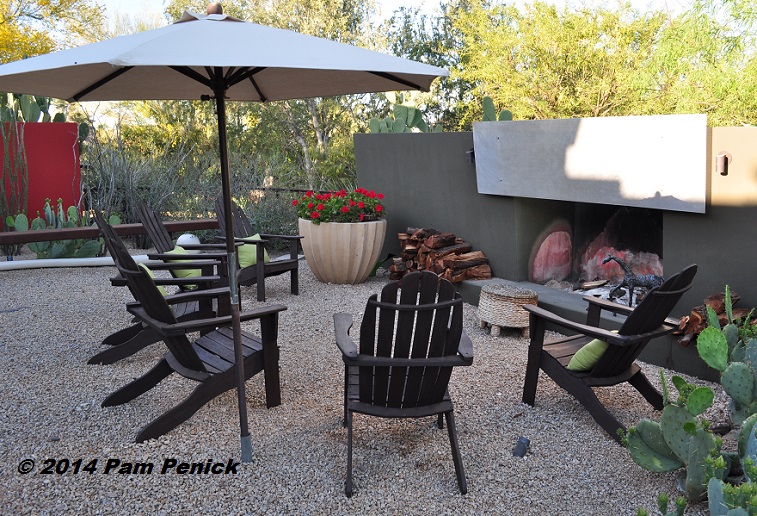
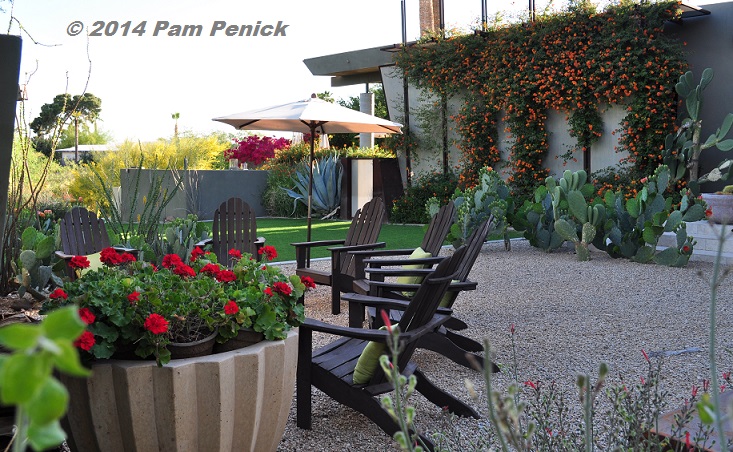
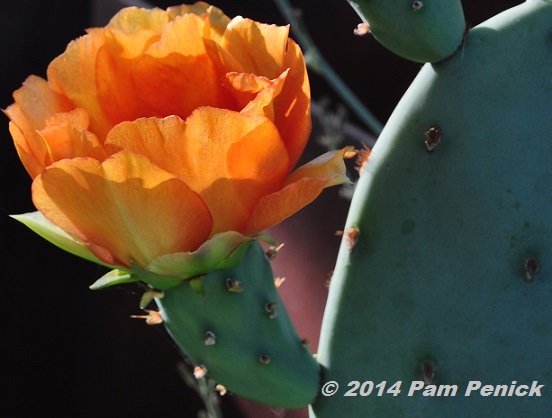
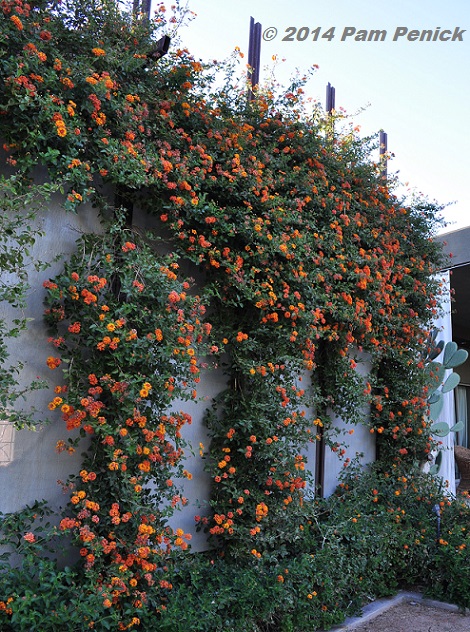
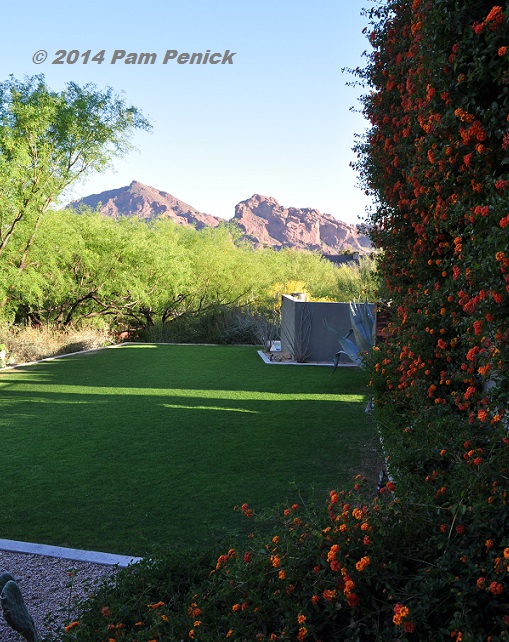
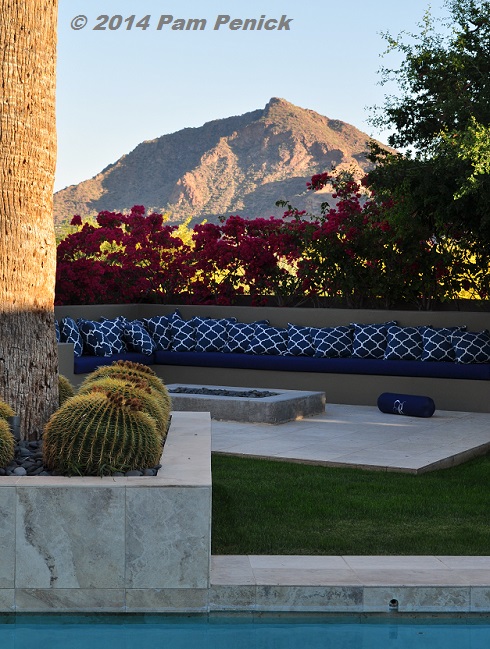
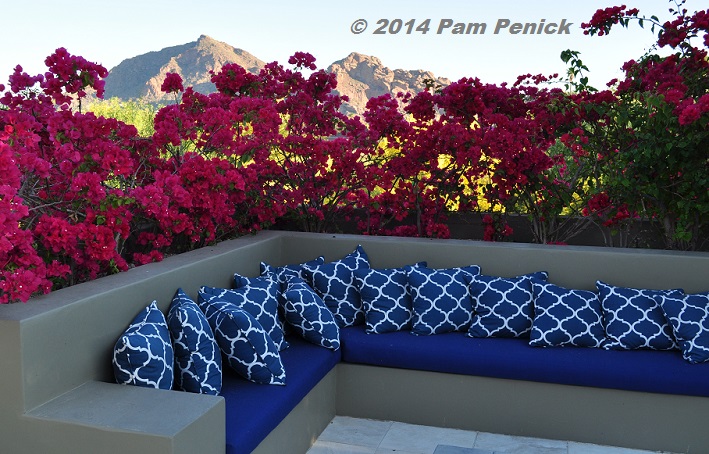
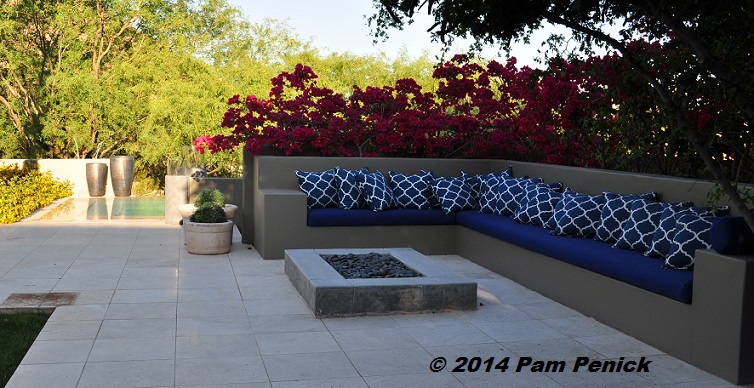
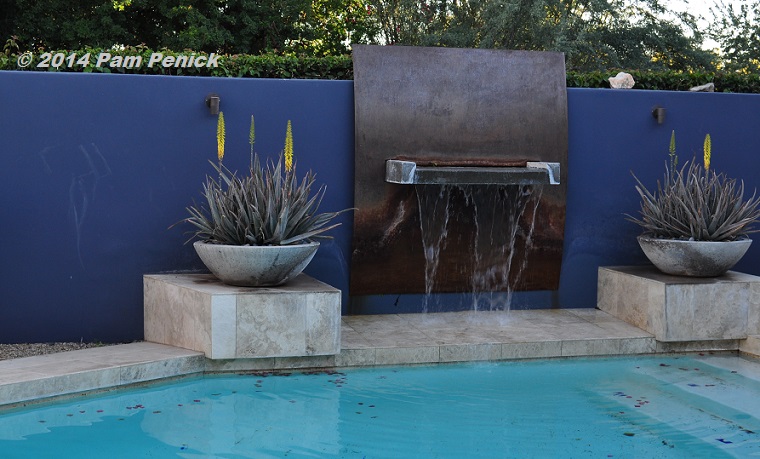
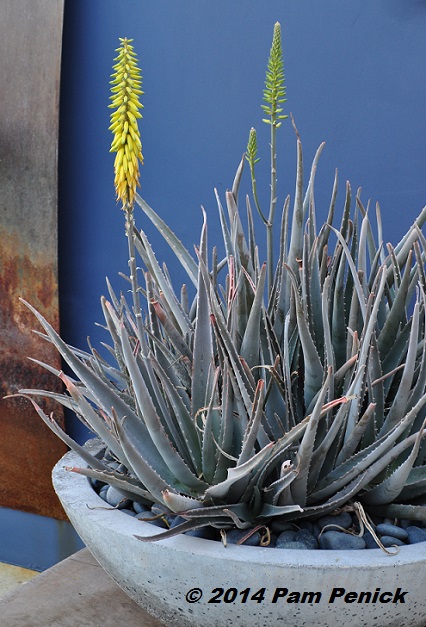
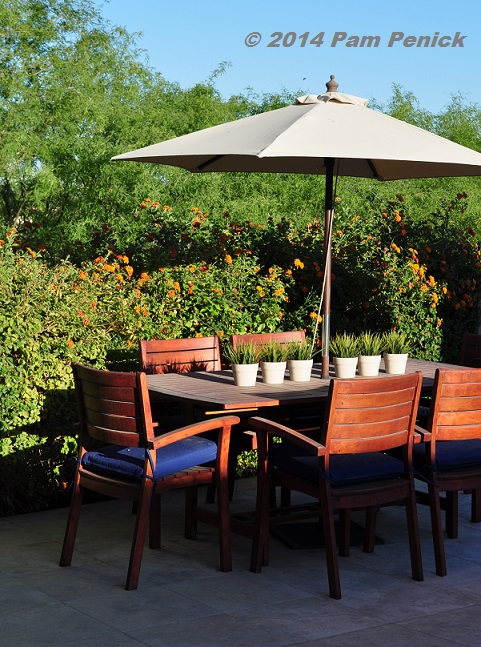
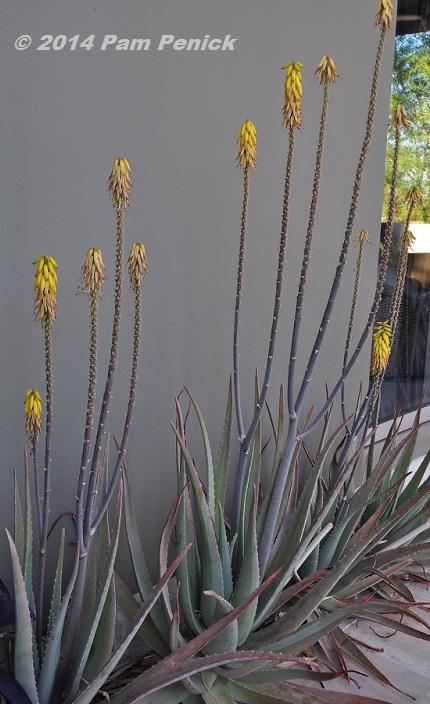
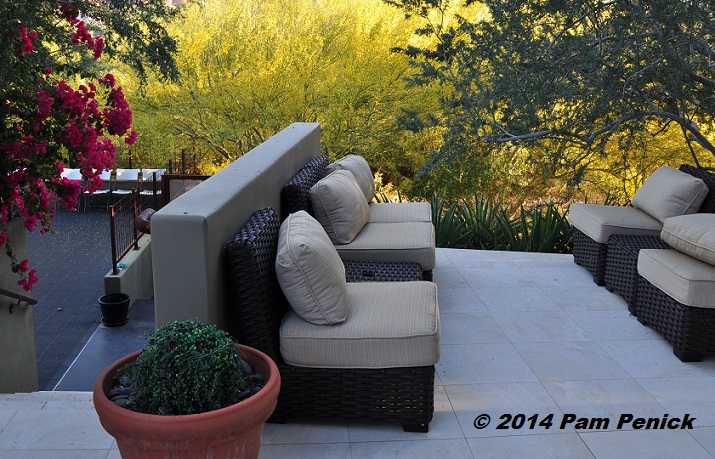
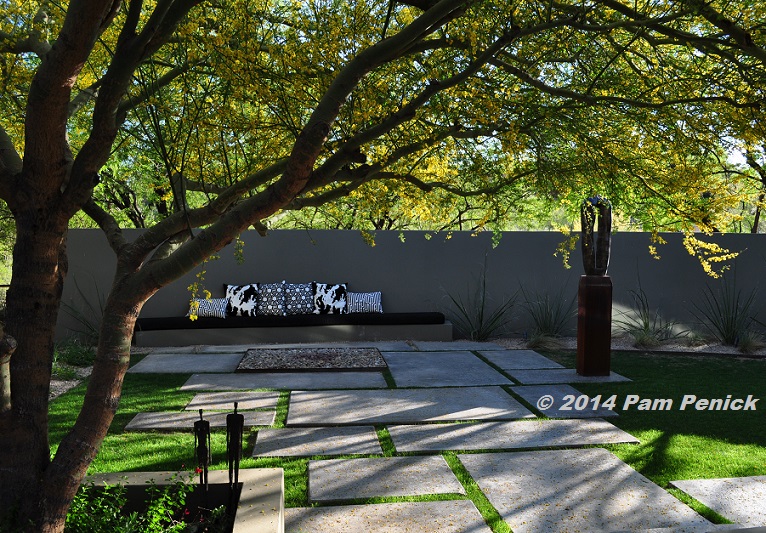
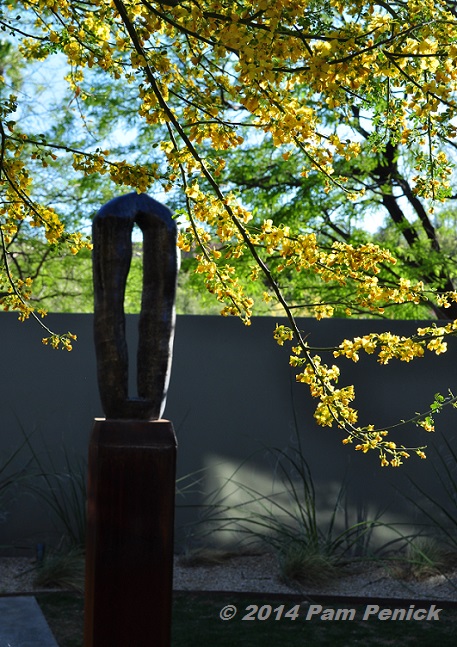
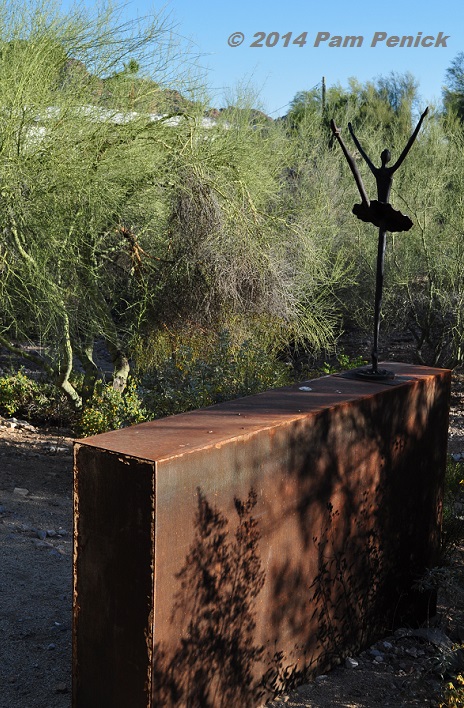
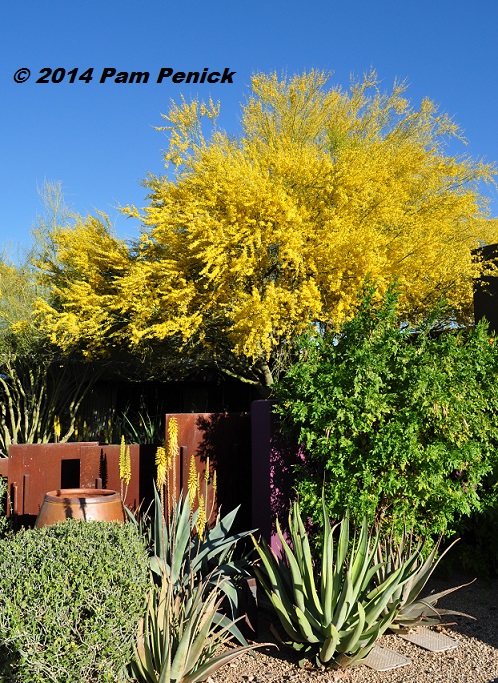
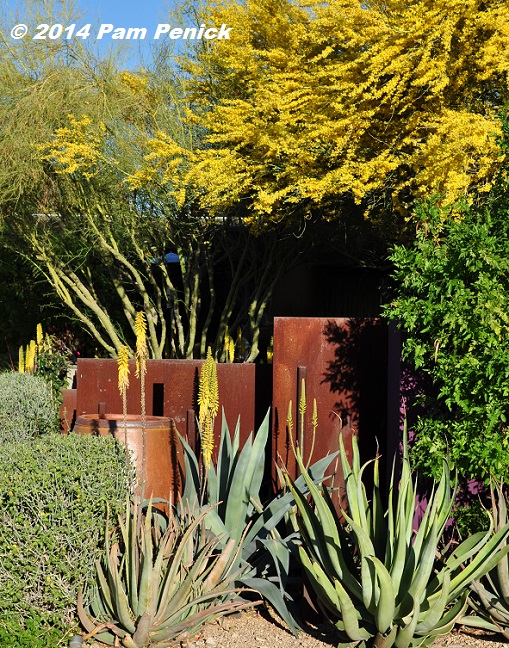
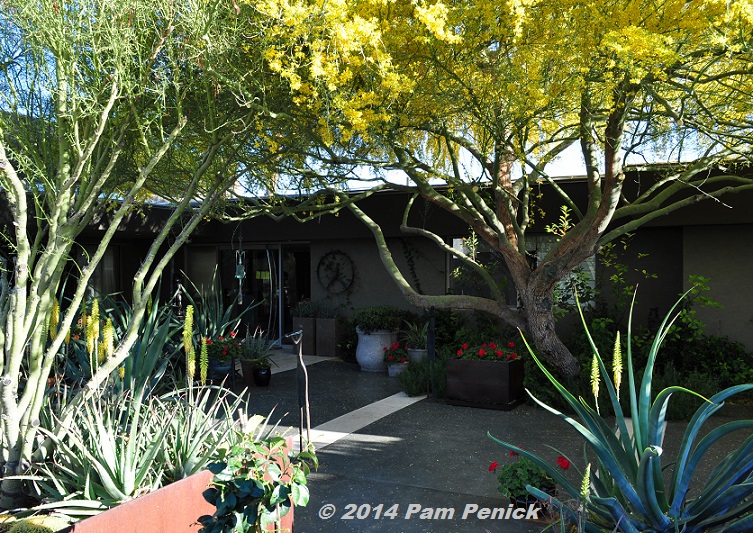
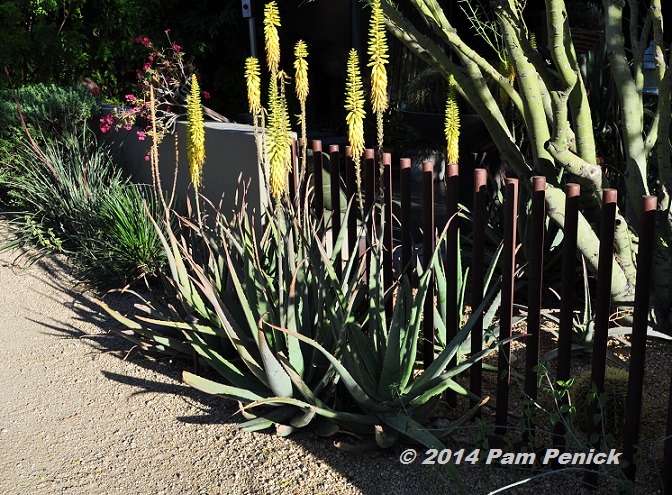
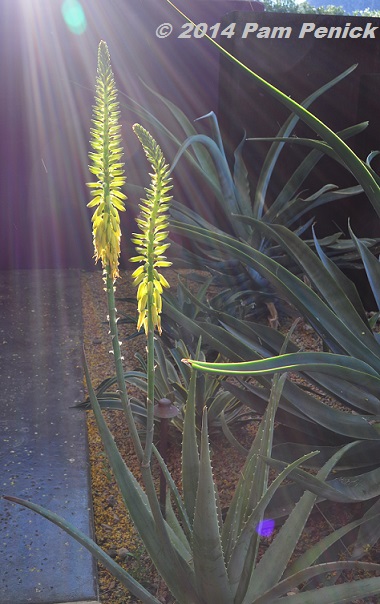
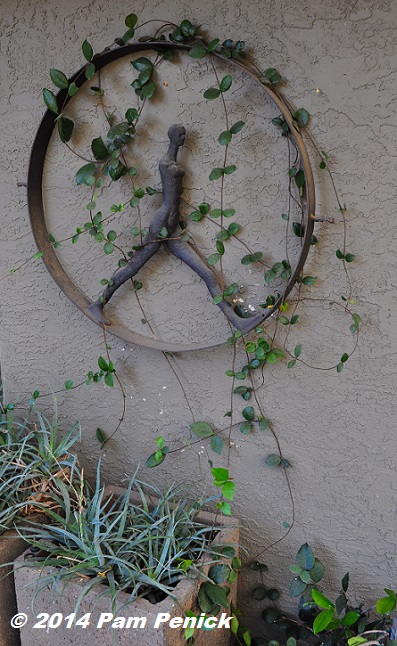
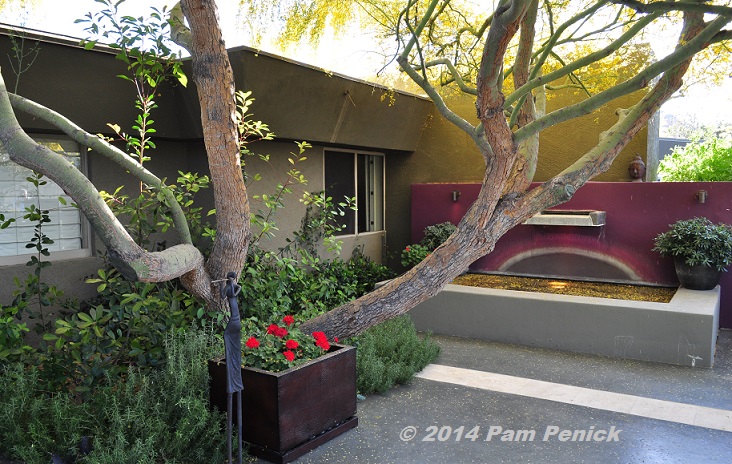
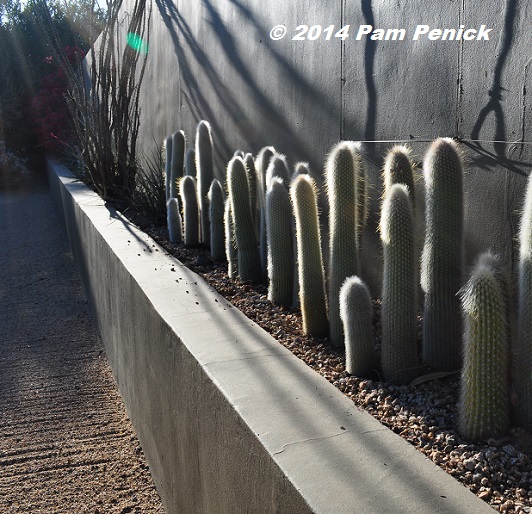
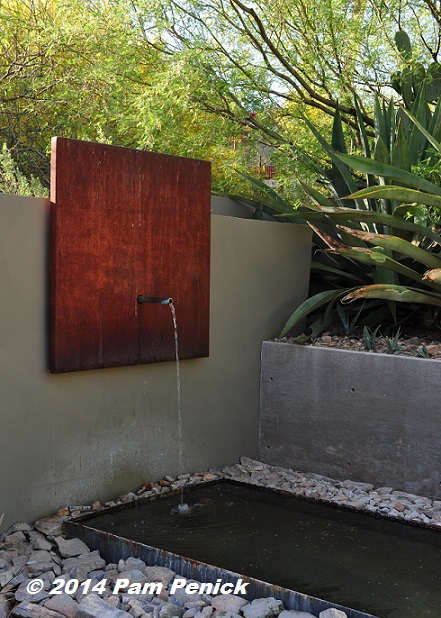
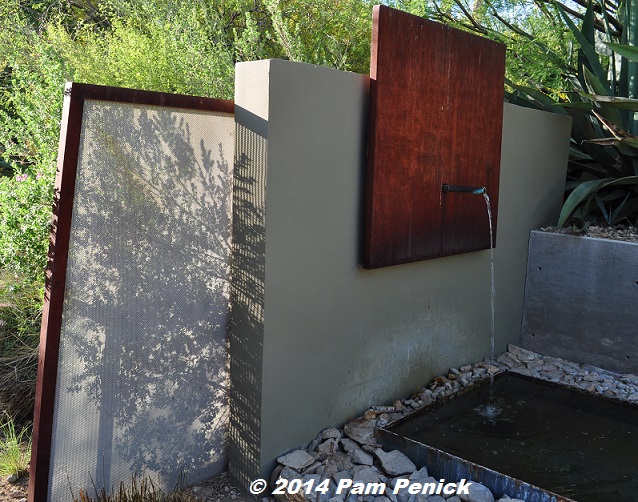
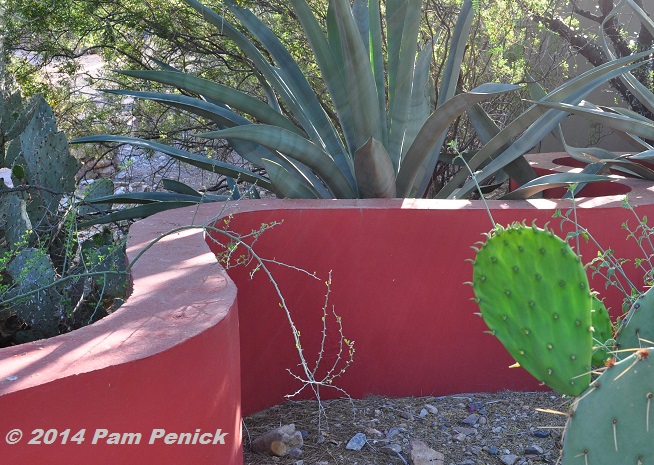
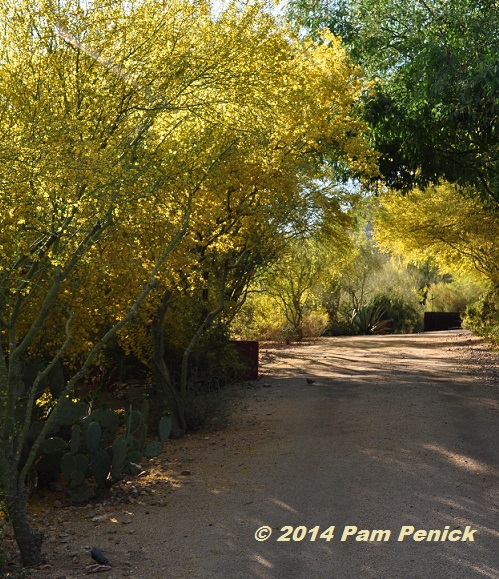
So much beautiful design in one garden. I love the sculptural plants set off by the walls. Your camera must have been clicking away all the time. I hope you had the opportunity to sit down in one of their wonderful seating areas and just drink in the beauty of the desert plantings.
My camera was indeed clicking, Jenny, and I did sit on the dining patio steps for a few moments — it was my favorite spot in the garden, among many fine spots. —Pam
Both aloes and euphorbia would require protection during our week or so of below freezing night temps that occur in Dec or Jan each year. This year it was the second week of Dec, and caught me off guard. I tent mine and put in a chick brooder lamp – and they are under roof protection on the porch and patio.
I’ve seen many huge specimens of Sticks on Fire disappear in January.
I grow those here in Austin, where they require even more winter protection. But oh how they thrive in summer! Only succulent-crazed gardeners like us would be willing to do what it takes to grow such plants, right? (Or replace them in spring.) —Pam
I usually don’t like much of the sculpture that shows up in private gardens but those introduced by the owner all seemed to fit the space well. Another lovely tour, Pam!
Yes, I thought the sculpture fit beautifully into this garden. —Pam
Another beautiful garden. Thank you for sharing, but if you ever find out what sort of horticultural witchcraft it took to get Lantana to grow like that, I want to know.
Will do, Les. Probably the homeowner trained it up the posts by tying it, but I never knew it would grow that tall. —Pam
Les isn’t the only one who wants to know the trick to getting Lantana to grow up a wall! So do I. Thanks for the beautiful tour of two gardens by a LA whose work I have known about and admired for some time.
Sounds like it’s time for some lantana experiments. Although I suppose you’d have to live where it doesn’t freeze back very often to do it. —Pam
Damn.
These spaces are wonderful! I, too, am fascinated by that lantana. Never seen that before!
Interesting take on this series of spaces, and that light I cannot get enough of.
I’ve never heard of “banquette” before, but those Arizona folks are *different*…a seat wall with a back is called a “banco” (bahn-ko) in Albuquerque & north, but not sure down here. So well-thought out, and reduced to the necessary i=with colored hardscape and plants.
And I missed all the shots you took of the ocotillo – engelmann prickly pear…giving me serious ideas!!! (actually I did that at the old house…must.do.again.)
I’m done!
Right after I wrote this post, I was reading a Sunset garden book and saw similar, built-in seating called a banco. So thanks for confirming. I’ll make the change in the post. The term “banquette” is perhaps only used for built-in kitchen seating. I see them in shelter magazines all the time. —Pam